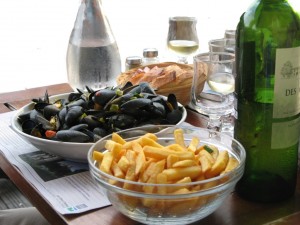
As July dawned we climbed into our car and fled to France. We left a hectic June behind us: our wonderful Open Garden weekend, the tragic loss of two good friends, the referendum and a country in political chaos. Wearily we boarded the great “Amorique” in Plymouth bound for Roscoff. We set off for a quiet week with friends in northern Britanny. It seems we were just in time, the calm before the storm, before terrorist attacks across France and Germany left even more pain, distress and uncertainty. We were lucky, our busy Sunday night channel crossing ran like clockwork. By late morning on Monday we were relaxing in the beautiful La Ville Douallan just south of Lamballe.
We laughed together, went for long walks, visited beautiful little villages and towns, ate wonderful food. We relaxed in their garden in the evening sun, amongst the roses, enjoying the “aperitif”.

And of course we went, as usual, to the Moulerie de la Baie at Jospinet, a tiny bay, on the coast just west of Pleneuf-Val-Andre. Every time we visit we make the little pilgrimage north to eat Antoine’s wonderful Bouchot moule.
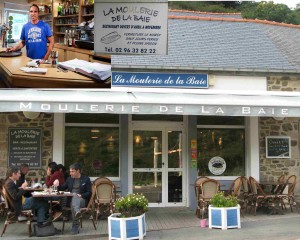
This time it was extra special. We arrived a little early. It was a beautiful evening so we strolled down the slipway to the sea. As we reached the water’s edge we watched large fishing boats approaching. A tractor and trailer drove past us to meet them. Suddenly the boats, one at a time, rose out of the water like huge dinosaurs and drove onto the slipway on great wheels. No mooring lines, no quay, no jetty, they simply drove up the slipway onto the road.



The first boat stopped briefly to unload part of the catch onto the tractor and trailer then off they all went down the road to their depot. We crept by later to see these strange boat-lorries neatly parked up in a line on dry land, fisherman’s wet suits drying beside them in the evening breeze!
Antoine fed us huge wonderful plates of moule and frites. He let us take photographs of his lovely restaurant as he explained how the mussels are sourced.
Bouchot mussel culture is an intertidal traditional aquaculture technique for farming mussels. The bouchots, French for pilings, are placed in the sea and the mussels are grown on ropes strung from these poles. According to a French C16th text, bouchot mussels go back to 1235 when a Scotsman, Patrick Walton was shipwrecked in the Bay of d’Aiguillon. He began to hunt seabirds, just as he had in Scotland, by driving wooden poles into the sea and stretching nets between them. He noticed mussels growing on the poles and he soon realised it was much more profitable to grow mussels than hunt seabirds. The modern bouchot technique took off in 1954 and Normandy and Brittany are the leading producers. There are thousands and thousands of poles in the bay of St Brieuc alone, owned by many different mussel farmers.

Mussel farming is growing in our waters here in the South West too. There are sites in Lyme Bay, Exmouth and Brixham Harbour. Our own wonderful Anchorstone cafés in Dittisham, Dartmouth and Sharpham serve delicious Moules Mariniere. Claire Harvey, chef-patron, told me she sources her mussels from Brixham where the waters are clear and there is a strong tidal flow. They are a naturally occurring hybrid of the Mytilus Edulis mussel (the native or blue mussel) and Mytilus Galloprovincialis (the Mediterranean mussel) which is well suited to conditions found in Torbay..
The whole process is surprisingly natural, creating a local haven for all sorts of other marine life. Once the poles and nets are in place the wild spat or free floating planktonic seed mussels fix themselves to the structures. No special feed is required, no chemicals or fertilisers, just clean tidal waters.
By the time the seed mussels are about two centimetres long, usually in August, they need thinning. The seed collecting lines are pulled up and stripped and the seed mussels are fed into “sockings”, a continuous cotton stocking with a rope down the middle onto which the mussels attach themselves. They put out byssal threads and secrete a cement- like fluid which hardens in the water. This way they anchor themselves to the ropes and feed on the tiny micro-organisms in the tidal flow. When they are 18 months to 2 years old and 50 to 60 mm long the mussels are harvested from the growing lines. Cylinders with two open doors at the bottom are lowered over the poles. The doors are then closed and as the cylinders are raised they strip the mussels from the ropes. After grading and landing, the live mussels are placed in cleansing depuration tanks before being distributed to fish markets, wholesalers and restaurants.
Moules Mariniere
This is the classic mussel dish, so quick and easy to prepare and so delicious!
But first make absolutely sure the mussels are clean and grit- free. To do this tip them into a large bowl and cover with plenty of cold water. Scrape away the hairy beard or byssus which attached the mussel to the rope or rock on which it grew. Throw out any which are damaged or refuse to open in the water. Drain and rinse again in more water. Don’t be tempted to leave them too long in fresh water; it will kill them.
Allow at least 50 grams of mussels per person, more if you have them!
To feed four people chop two onions and a couple of fat cloves of garlic. Put the onion, garlic, 3 tablespoons of chopped parsley, 200ml white wine, 150ml water and a little black pepper in a large pan. Simmer for ten minutes then raise the heat and when the liquid is boiling quickly, tip in the mussels. Put a lid on the pan and give it a good shake over the heat for a few minutes until the mussels are open. Discard any that refuse to open.
Scoop out the cooked mussels into a warm bowl and keep warm. Strain the liquor through a fine sieve or coffee filter paper to remove any stubborn grit, then return to the pan and quickly bring to the boil while whisking in 30grms of butter. Serve the mussels in their liquor with more chopped parsley, crusty bread or, of course, the ubiquitous frites!
There are, of course, many variations on this theme! At Antoine’s Moulerie a couple of weeks ago I had a delicious version with tiny leeks, pancetta and cream. Others chose mild curry spices, both quite wonderful.
Next time it will be Brixham Moule at the Anchorstone café!

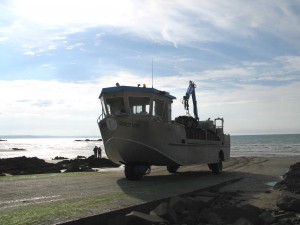


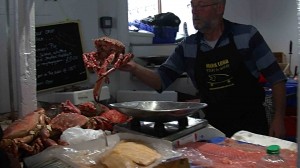
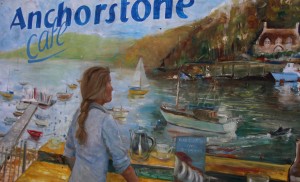
Leave a Reply